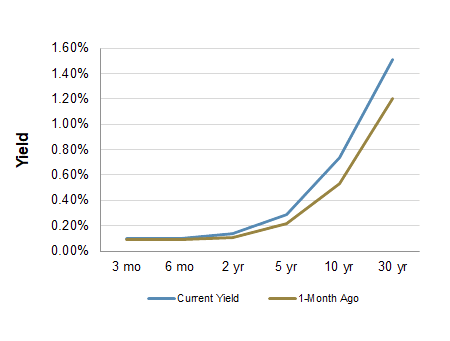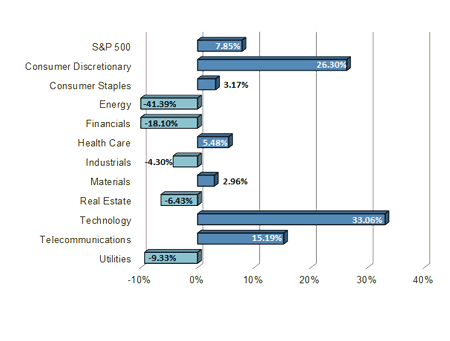Chief Economist Scott Brown discusses the latest market data.
The Fed updated its monetary policy framework, moving to a flexible average inflation target. That means that the central bank will target an average inflation rate of 2% (as measured by the PCE Price Index) over time. A period of inflation below 2% would be followed by a period of above 2% inflation, but not in a mechanical or mathematical way (judgment remains the key element). According to Fed Chair Powell, that’s not a big change from how policy has been conducted in recent years. The Fed also made its employment goal broader and more inclusive (recognizing that low unemployment greatly benefits low- and medium-income communities).
Real GDP fell at a 31.7% annual rate in the second estimate for 2Q20, vs. -32.9% in the advance estimate. Personal income rose 0.4% in the initial estimate for July (+8.2% y/y), as a 1.4% gain in wages and salaries (-1.1% y/y) offset a 7.2% decline in unemployment benefits (+4,833% y/y). Personal spending rose 1.9% (-2.8% y/y). The PCE Price Index ex-food & energy rose 0.3% in July (+1.0% y/y), up 0.3% ex-food & energy (+1.3% y/y). Durable goods orders jumped 11.2% in July, as a 21.9% increase in orders for motor vehicles more than offset nearly $5 billion in aircraft order cancellations. Ex-transportation, orders rose 2.4%.
Next week, fresh August data begin to arrive, with a focus on Friday’s employment figures. Nonfarm payrolls are expected to rise further, boosted by the hiring of temporary census workers, while the start of the school year may add some noise. The unemployment rate should fall further, partly reflecting a decrease in labor force participation. ISM surveys should be consistent with a moderation in the pace of growth in August (diffusion indices reflect direction, not absolute strength). The Labor Department’s report on jobless claims will shift to additive seasonal adjustment (vs. the previous multiplicative adjustment), which should add about 45,000 to the unadjusted figure (instead of multiplying by 1.22) and make comparisons to previous adjusted figures invalid (as the history won’t be revised).
Indices
| Last | Last Week | YTD return % | |
|---|---|---|---|
| DJIA | 28492.27 | 27739.73 | -0.16% |
| NASDAQ | 11625.34 | 11264.95 | 29.56% |
| S&P 500 | 3484.55 | 3385.51 | 7.85% |
| MSCI EAFE | 1902.25 | 1885.94 | -6.61% |
| Russell 2000 | 1564.56 | 1564.30 | -6.23% |
Consumer Money Rates
| Last | 1 year ago | |
|---|---|---|
| Prime Rate | 3.25 | 5.25 |
| Fed Funds | 0.00 | 2.11 |
| 30-year mortgage | 2.95 | 3.56 |
Currencies
| Last | 1 year ago | |
|---|---|---|
| Dollars per British Pound | 1.3201 | 1.221 |
| Dollars per Euro | 1.1822 | 1.108 |
| Japanese Yen per Dollar | 106.57 | 106.12 |
| Canadian Dollars per Dollar | 1.313 | 1.331 |
| Mexican Peso per Dollar | 22.149 | 20.111 |
Commodities
| Last | 1 year ago | |
|---|---|---|
| Crude Oil | 43.04 | 55.78 |
| Gold | 1932.60 | 1549.10 |
Bond Rates
| Last | 1 month ago | |
|---|---|---|
| 2-year treasury | 0.14 | 0.11 |
| 10-year treasury | 0.74 | 0.53 |
| 10-year municipal (TEY) | 1.22 | 1.02 |
Treasury Yield Curve – 08/28/2020

As of close of business 08/27/2020
S&P Sector Performance (YTD) – 08/28/2020

Economic Calendar
| September 1 | — | ISM Manufacturing Index (August) |
| September 2 | — | ADP Payroll Estimate (August) |
| — | Factory Orders (July) | |
| — | Fed Beige Book | |
| September 3 | — | Jobless Claims (week ending August 29) |
| — | Trade Balance (July) | |
| — | ISM Non-Manufacturing Index (August) | |
| September 4 | — | Employment Report (August) |
| September 7 | — | Labor Day Holiday (markets closed) |
| September 11 | — | Consumer Price Index (August) |
| September 16 | — | Retail Sales (August) |
| — | FOMC Policy Decision | |
| October 29 | — | Real GDP (3Q20, advance estimate) |
| November 3 | — | Election Day |
| November 5 | — | FOMC Policy Decision |
All expressions of opinion reflect the judgment of the Research Department of Raymond James & Associates, Inc. and are subject to change. There is no assurance any of the forecasts mentioned will occur or that any trends mentioned will continue in the future. Investing involves risks including the possible loss of capital. Past performance is not a guarantee of future results. International investing is subject to additional risks such as currency fluctuations, different financial accounting standards by country, and possible political and economic risks, which may be greater in emerging markets. While interest on municipal bonds is generally exempt from federal income tax, it may be subject to the federal alternative minimum tax, and state or local taxes. In addition, certain municipal bonds (such as Build America Bonds) are issued without a federal tax exemption, which subjects the related interest income to federal income tax. Municipal bonds may be subject to capital gains taxes if sold or redeemed at a profit. Taxable Equivalent Yield (TEY) assumes a 35% tax rate.
The Dow Jones Industrial Average is an unmanaged index of 30 widely held stocks. The NASDAQ Composite Index is an unmanaged index of all common stocks listed on the NASDAQ National Stock Market. The S&P 500 is an unmanaged index of 500 widely held stocks. The MSCI EAFE (Europe, Australia, Far East) index is an unmanaged index that is generally considered representative of the international stock market. The Russell 2000 index is an unmanaged index of small cap securities which generally involve greater risks. An investment cannot be made directly in these indexes. The performance noted does not include fees or charges, which would reduce an investor’s returns. U.S. government bonds and treasury bills are guaranteed by the US government and, if held to maturity, offer a fixed rate of return and guaranteed principal value. U.S. government bonds are issued and guaranteed as to the timely payment of principal and interest by the federal government. Treasury bills are certificates reflecting short-term (less than one year) obligations of the U.S. government.
Commodities trading is generally considered speculative because of the significant potential for investment loss. Markets for commodities are likely to be volatile and there may be sharp price fluctuations even during periods when prices overall are rising. Specific sector investing can be subject to different and greater risks than more diversified investments. Gross Domestic Product (GDP) is the annual total market value of all final goods and services produced domestically by the U.S. The federal funds rate (“Fed Funds”) is the interest rate at which banks and credit unions lend reserve balances to other depository institutions overnight. The prime rate is the underlying index for most credit cards, home equity loans and lines of credit, auto loans, and personal loans. Material prepared by Raymond James for use by financial advisors. Data source: Bloomberg, as of close of business August 27, 2020.
Markets & Investing Members of the Raymond James Investment Strategy Committee share their views on...
Markets & Investing Review the latest Weekly Headings by CIO Larry Adam. Key Takeaways ...
Technology & Innovation Learn about a few simple things you can do to protect your personal information...